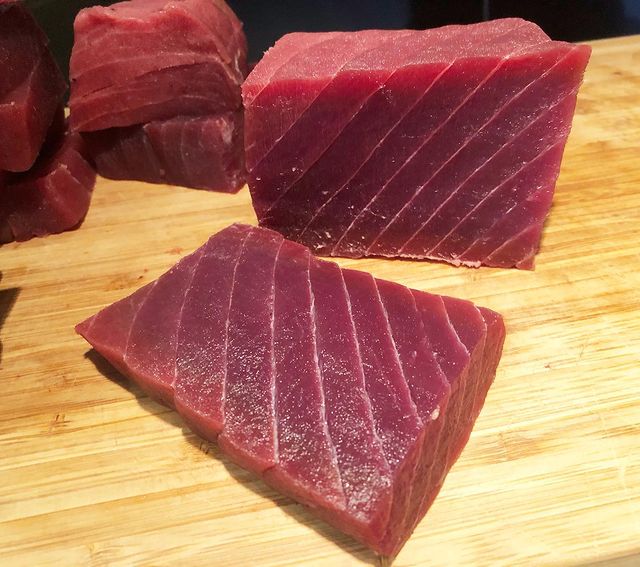Tuna is a crucial staple in healthy human diets and is one of the most popular fish that humans consume. So, it makes sense to wonder if your dog can consume it safely too. Dog food companies use tuna as one of their ingredients. However, food experts have raised concerns regarding the safety of feeding tuna to dogs. So, if humans can safely consume tuna, can dogs do the same?
Dogs can only eat cooked tuna fish. Raw tuna should not be fed to dogs due to its mercury content and other health concerns. In fact, consuming tuna is regarded to be both safe and harmful for dogs. Tuna has become a controversial source of protein for dogs because of where this large fish stays.
Nowadays, the sea and oceans are heavily polluted with mercury which is caused by burning fossil fuels, volcanic eruptions, and forest fires. Smaller fish will consume the mercury, and then the larger fish like tuna will eat the smaller fish. As a result, feeding dogs with tuna should always be done with care.
This article will help you understand when it’s okay and when it’s not okay to feed your dog tuna. Keep reading to find out everything you need to know about feeding your dog with tuna. This includes the risks, benefits, how much and in what form dogs should be consuming it, and more. Thus, helping keep your dog healthy and happy at all times.
Can Dogs Eat Raw Tuna?

No, you should not give raw tuna to dogs as it is not the safest choice. Any type of raw fish can have parasites or germs that will make your puppy very sick. Raw tuna also contains the thiaminase enzyme, which doesn’t allow absorption of the vitamin in the body system.
What Is Tuna?
Tuna is a saltwater fish that is part of the mackerel family. Tuna fish comes with a streamlined and sleek body that ensures it can propel easily in water. They are found in warm ocean waters and are always fished for human consumption.
However, there are many different types of tuna that come in different shapes, designs, sizes, and colors. They range from one foot to 15 feet long and can weigh up to 1,500 lbs. The oldest tuna is said to have lived for about 50 years, although a few types are close to extinction.
Different Types Of Tuna
As mentioned earlier, there are many (over 20) different types of tuna that are available today. However, only five types are safe for consumption. They include Skipjack, Bigeye, Yellowfin, Albacore, and Bluefin.
Similar to many fish types, tuna is an excellent source of omega-3 and protein which is vital to keep the dog healthy. However, unlike other types of fish like tilapia and salmon, raw tuna has higher levels of mercury that could cause fatal or severe health complications.
Mercury Content
Mercury enters the seas, oceans, rivers, and lakes through industrial activities and then accumulates in fishes. Ideally, the larger the fish, the longer it will live and, therefore, the higher the concentration in their tissues. Since tuna are long-living and large, their mercury levels are found to be quite high.
What Are The Symptoms of Mercury Poisoning in Dogs?
While a little bit of tuna might not cause any harm, tuna can be toxic to dogs when consumed in large amounts. Mercury poisoning can easily kill your dog if the signs aren’t noticed early and the dog is not treated quickly.
Here are some mercury poisoning symptoms you should look out for:
- Tremors
- Vomiting blood
- Bloody or watery diarrhea
- Hair loss
- Blindness
- Anxiety or nervousness
- Fever
- Kidney damage (inability to urinate, abdominal swelling)
- Loss of coordination
- Distended abdomen
- Weight loss
- Loss of feeling in their paws
If your dog takes large amounts of tuna and starts exhibiting the above symptoms, be sure to visit a vet right away. However, mercury damage is permanent and affects the quality of life, especially when it has caused severe damage to the nervous, renal, and cardiovascular systems.
Furthermore, treating mercury poisoning can be very expensive, so it is always a great idea to keep the mercury items out of the dog’s reach.
Tips For Serving Tuna To Dogs

As much as it is convenient to allow your dog to take tuna fish, it is for sure not the safest meal option for dogs. Hence, you should keep the following tips in mind while serving your tuna for your dog;
- Ensure that the tuna is properly cooked to remove any harmful bacteria and parasites.
- When buying canned tuna, make sure you buy the water-based tuna cans and not tuna in oil. Furthermore, avoid additional seasonings and flavorings.
- Avoid adding seasonings and salt to the tuna as they may cause more harm than good. Dogs will enjoy tuna without any additives.
- Remember that dogs are not the best with bones as bones get locked up in their air passage and become a choking hazard.
- To get rid of as much salt as possible, you can soak the tuna overnight in water before cooking it and serving your dog.
- When introducing tuna to your dog, it is essential to take it slowly. Introduce it little by little and wait to see how the dog will react before giving them another bite.
- Look for tuna with lower mercury levels like albacore or skipjack to avoid mercury poisoning.
- Dogs should not feed on the head, tail, and fins to dogs as they can be a choking hazard, increase the intestinal perforation risk, or cause an oral trauma.
Cooked Tuna Recipe For Dogs
Preparing tuna to be consumed by dogs is quite simple. However, there are several different recipes you could try out, but here is our favorite one;
Ingredients Needed
- One can of tuna in spring water
- One can of salmon
- One cup of wheat flour
- Four eggs
Cooking Procedure
- Gently mix all the above ingredients.
- Put the mixture in a baking bowl.
- Put the bowl in the oven and bake at 350°F for about 40 minutes.
- After proper baking, the results should be golden brown tuna.
Can Dogs Eat Canned Tuna?
Your 20-pounder dog should feed on one can of tuna every two weeks. Canned tuna is the easiest way to supplement your dog’s diet with fish, as it is cheaper and more convenient than cooking raw tuna fillets bought from the nearest supermarket.
Besides, canned tuna offers health benefits, such as reducing inflammation and maintaining healthy brain tissues. Skipjack tuna and Albacore meat are commonly sold in the US, given that they have lower mercury levels, translating to safer consumption of tuna from a can.
Feed your dog canned tuna that hasn’t been salted and is packaged in water rather than oil. Unlike oil-packed tuna, a can of tuna packed in water without any added fats or additives provides fewer calories, making it appropriate for recipes that include richer components.
For this, we highly recommend Almo Nature HQS Natural Tuna Fillet Entrée. Simply pour it into a bowl together with dry kibble and serve. Your pooch will happily be munching away.
Can Dogs Eat Tuna in Brine?
While a small amount of tuna in brine is not harmful, it is advisable to avoid feeding it to your dog. This is because tuna in brine contains too much salt, which is harmful to dogs and could lead to sodium poisoning.
Can Dogs Eat Tuna In Sunflower Oil?
Unlike tuna in brine, tuna in sunflower oil has a little salt. Furthermore, sunflower oil has less saturated fat than other oils and contains omega-6. However, consuming too much of this oil can cause unhealthy weight gain and sometimes inflammation.
As a result, it is crucial to drain the fish thoroughly to ensure it is safe for your dog to consume tuna in sunflower oil. While eating sunflower oil is considered safe for your dog, the best choice by far is tuna in spring water because it has less fat and salt than other types of canned tuna.
Can Dogs Eat Tuna With Mayo?
Generally, dogs can eat tuna with mayonnaise. In fact, they tend to enjoy a nice tuna fish sandwich. However, be careful when feeding the dog with mayonnaise as too much of it can lead to excessive weight gain, which risks of obesity will ensue.
How Much Tuna Can I Give My Dog?
Give your dog one or two little bite-size slices of tuna once a week. Tuna should only be introduced to your dog’s diet as a special treat, not as a daily routine, because too much tuna can be harmful.
If you always serve your dog tuna, wait a few days before feeding them again. Although bigger dogs can consume tuna sooner than younger pups, most dog owners retain tuna as a special treat. To be safe, always feed tuna in moderation.
Do Dogs Like Tuna?
Yes, most dogs will enjoy the taste of tuna. This is because dogs are naturally carnivores and the taste of fish, which includes tuna, is delicious for a lot of dogs.

Can Puppies Eat Tuna?
No, it would be best not to feed your puppy tuna. The first couple of months of a puppy’s life require specialized puppy diets, and tuna is not one of the recommended meals. This could cause some permanent health issues and sometimes lead to the death of the puppies.
Can Pregnant Dogs Eat Tuna?
It is not advisable to feed pregnant dogs tuna. While pregnant dogs may benefit from the extra lean protein in tuna, other types of fish are considered better off. This is because of the high risks and complicated procedures involved with consuming tuna.
Do Dogs Benefit From Eating Tuna?
Tuna comes with several health benefits, as discussed below:
- Tuna is enriched naturally with vitamins B12, B3, and B6. These B-complex vitamins will boost your dog’s immune system.
- Your dog also ingests different essential minerals such as magnesium, calcium, and phosphorus, which are essential in strengthening the bones.
- Tuna contains Omega-3 fatty acids, which help to maintain your dog’s healthy coat. It prevents coat itching and inflammations.
- It provides enough protein for your dog and gives protection against unwanted fat.
- Tuna has antioxidants that help minimize the effects of free radicals in the body.
- It is relatively low in sodium, unlike other types of fish.
Can Tuna Help Dogs With Kidney Disease?
Generally speaking, dogs that have kidney disease will do better with a low protein diet. Since the kidney helps remove excess protein, a low protein diet will ensure the kidney takes a break. For this reason, if your dog has kidney problems, it is important to minimize tuna consumption or any other high-protein meals.

Is Tuna Good For Dogs With Sensitive Stomachs?
As mentioned earlier, tuna is sometimes added to commercial dog foods. This is meant to help dogs who have sensitive stomachs and have trouble processing other kinds of protein. However, every dog is different, and the food intolerance and sensitivities may differ from one dog to another.
Does Dog Food Contain Tuna?
Yes, several commercial dog food brands have added tuna to their recipes. However, most dog food brands will instead use safe freshwater fish, for example, salmon, as their main ingredient.
Alternatives To Tuna For Dogs
If you’re looking to give your dog a new type of protein but are worried about the mercury levels, there are other protein options out there.
For example, salmon is another great fish type to give to your dog. It is an excellent source of protein and comes with numerous benefits. It is rich in Omega-3 to reduce inflammation and improve digestion, enhance growth and development, and is also high in antioxidants and vitamins.
Other possible sources of protein you could feed your dog are shrimp, whitefish, flounder, herring, eggs, etc.





